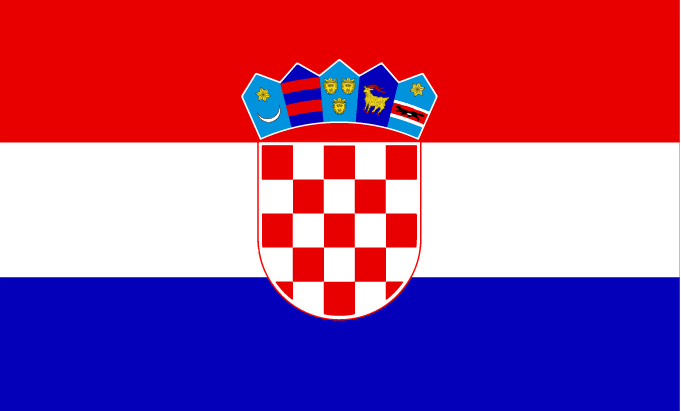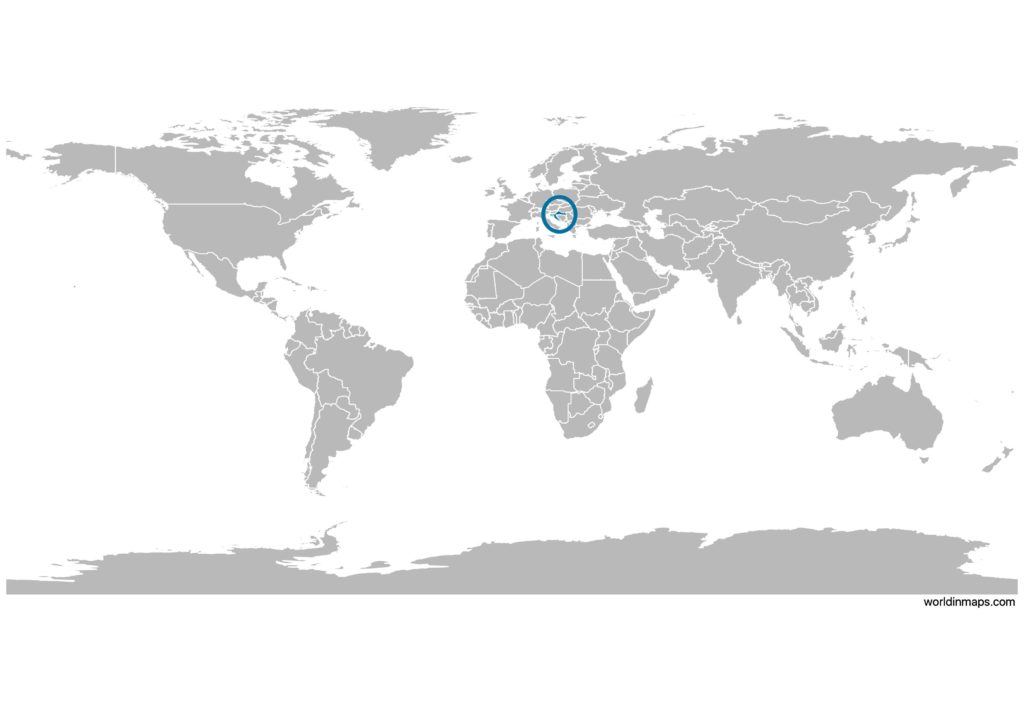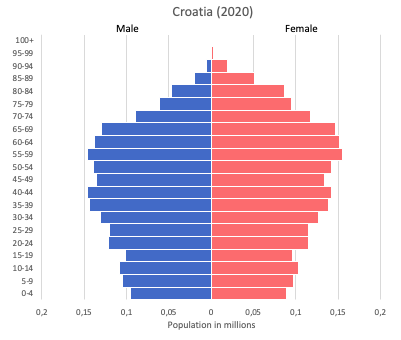Croatia

| Government | |
| Name | Republic of Croatia |
| Croatian | Republika Hrvatska |
| Government type | Parliamentary republic |
| Capital | Zagreb (1,228,941 (2011)) |
| Currency | Kuna (HRK) |
| People | |
| Population (2020) | 4,105,268 (130th) |
| Density of population | 73 P/km2 (109st) |
| Nationality | Croatian |
| Official languages | |
| Croatian | |
| Ethnic groups (2011) | |
| Croat | 90.4% |
| Serb | 4.4 |
| Other | 4.4% |
| Unspecified | 0.8% |
| Religions (2011) | |
| Roman Catholic | 86.3% |
| Orthodox | 4.4% |
| Muslim | 1.5% |
| Other | 1.5% |
| Unspecified | 2.5% |
| Not religious or atheist | 3.8% |
| Life expectancy (2020) | |
| Male | 73.6 years |
| Female | 80.1 years |
| Total population | 76.7 years (88th) |
| Homicides | |
| Total (2018) | 0.6 per 100,000 people (158th) |
| Geography | |
| Land area | 55,974 km2 |
| water area | 620 km2 |
| total area | 56,594 km2 (128th) |
| Mean elevation | 331 m |
| Lowest point | |
| Adriatic Sea | 0 m |
| Highest point | |
| Dinara | 1,831 m |
| Land use (2011) | |
| Agricultural land | 23.7% |
| Arable land | 16% |
| Permanent crops | 1.5% |
| Permanent pasture | 6.2% |
| Forest | 34.4% |
| Other | 41.9% |
| Urbanization | |
| Urban population (2020) | 57.6% |
| Rate of urbanization | -0.08% annual rate of change (2015 – 2020) |
| Economy | |
| Labor force (2017) | 1.559 million (130th) |
| Labor force by occupation (2017) | |
| Agriculture | 1.9% |
| Industry | 27.3% |
| Services | 70.8% |
| Unemployment rate (2017) | 12.4% (164th) |
| GDP (PPP) (estimate 2020) | |
| Total | $117.928 billion (81st) |
| Per capita | $29,207 (55th) |
| GDP (nominal) (estimate 2020) | |
| Total | $63.172 billion (77th) |
| Per capita | $15,646 (55th) |
| GDP by sector (estimate 2017) | |
| Agriculture | 3.7% |
| Industry | 26.2% |
| Services | 70.1% |
| Exports (2017) | $13.15 billion (80th) |
| Exports partners (2017) | |
| Italy | 13.4% |
| Germany | 12.2% |
| Slovenia | 10.6% |
| Bosnia and Herzegovina | 9.8% |
| Austria | 6.2% |
| Serbia | 4.8% |
| Imports (2017) | $22.34 billion (71st) |
| Imports partners (2017) | |
| Germany | 15.7% |
| Italy | 12.9% |
| Slovenia | 10.7% |
| Hungary | 7.5% |
| Austria | 7.5% |
Croatia on the world map

Croatia top 10 largest cities (2011)
- Zagreb (1,228,941)
- Split (178,102)
- Rijeka (128,624)
- Osijek (108,048)
- Zadar (75,082)
- Pula (57,460)
- Slavonski Brod (59,143)
- Karlovac (55,705)
- Varaždin (46,946)
- Šibenik (46,332)
Demography
Population pyramid

Age structure data
Estimate for 2020:
- 0-14 years: 14.16% (male 308,668/female 289,996)
- 15-24 years: 10.76% (male 233,602/female 221,495)
- 25-54 years: 39.77% (male 841,930/female 839,601)
- 55-64 years: 14.24% (male 290,982/female 310,969)
- 65 years and over: 21.06% (male 364,076/female 526,427)
Remark: the age structure of a population affects a nation’s key socioeconomic issues. Countries with young populations (high percentage under age 15) need to invest more in schools, while countries with older populations (high percentage ages 65 and over) need to invest more in the health sector. The age structure can also be used to help predict potential political issues. For example, the rapid growth of a young adult population unable to find employment can lead to unrest.
Population from 1950 to 2020
Source: United Nations, Department of Economic and Social Affairs, Population Division (2019). World Population Prospects 2019, Online Edition. Rev. 1.
Evolution of the life expectancy from 1960 to 2018
Source: World Development Indicators, The World Bank
Economy
Agriculture:
arable crops (wheat, corn, barley, sugar beet, sunflower, rapeseed, alfalfa, clover); vegetables (potatoes, cabbage, onion, tomato, pepper); fruits (apples, plum, mandarins, olives), grapes for wine; livestock (cattle, cows, pigs); dairy products
Industries:
chemicals and plastics, machine tools, fabricated metal, electronics, pig iron and rolled steel products, aluminum, paper, wood products, construction materials, textiles, shipbuilding, petroleum and petroleum refining, food and beverages, tourism
Exports – commodities:
transport equipment, machinery, textiles, chemicals, foodstuffs, fuels
Imports – commodities:
machinery, transport and electrical equipment, chemicals, fuels and lubricants, foodstuffs
Time zone and current time in Croatia
Go to our interactive map to get the current time in Croatia